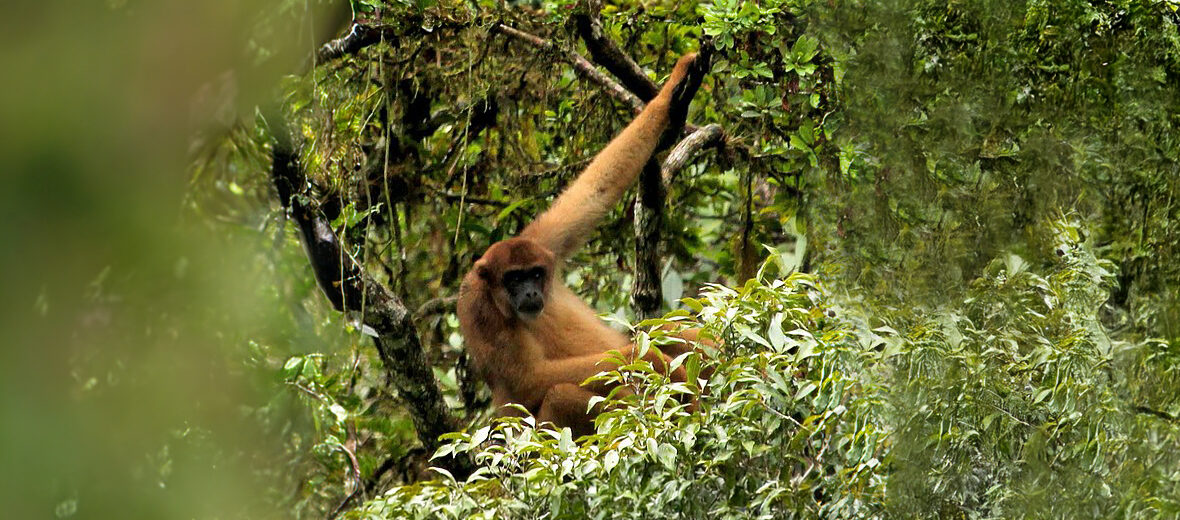
The southern muriqui, aka woolly spider monkey (a misnomer, as they are neither woolly monkeys nor spider monkeys), hails only in specific areas of the Atlantic rainforest located in Brazil, South America. More specifically in the states of Paraná, São Paulo, Rio de Janeiro, Espírito Santo, and Minas Gerais. These primates face a host of threats including the likes of habitat loss and destruction at the hands of tourism and recreational activities, farming, and ranching; deforestation at the hands of the logging, mining, and quarrying industries; hunting; trapping; and habitat division due to the construction of dams. The IUCN lists these monkeys as Critically Endangered. Their population trend is also listed as decreasing.
First the Stats…
Scientific name: Brachyteles arachnoides
Weight: Up to 33 lbs.
Length: Up to 30.5 inches, plus up to a 31.5 inches
Lifespan: Up to 40 years
Now on to the Facts!
1.) Muriquis are the largest New World (those found in the Americas) monkeys and largest non-human native primates in Central America and South America.
2.) They are also known locally as mono carvoeiro, which translates into “charcoal monkey”.
3.) These monkey’s tails are fully prehensile (used as an additional limb).
4.) A variety of fruits, seeds, and leaves comprise their diet. Tree bark is also consumed in a pinch. These primates have the most diverse fruit diet in the Atlantic.
5.) Seeing as these monkeys are frugivores (eat primarily fruit), they are important seed dispersers for the forest.
But wait, there’s more on the southern muriqui!
6.) Their dietary regimen also provides foraging opportunities for tapirs.
7.) Just like chimpanzees, male southern muriquis are philopatric (remain near a particular site or area), while females immigrate to spread genetic diversity and avoid incestuous breeding with their relatives. This helps to avoid inbreeding.
Did you know…?
Males within a community, or troop, are sometimes tolerant of each other and intergroup aggressiveness is uncommon among the northern muriquis.
8.) Unlike the hippy-esque northern muriquis though, southern muriquis often engage in acts of violence against one another.
9.) Their attitude towards outsider males is also not tolerated, as a group of males was once observed killing a male from outside their troop.
10.) There are only 2 captive populations in existence. Curitiba Zoo: Located in Curitiba, Brazil, and Sorocaba Zoo: Situated in Sorocaba, Brazil.
But wait, there’s still more on the southern muriqui!
11.) Females undergo up to a 7 month gestation (pregnancy) that yields a single infant.
12.) These primates are diurnal (active during the day).
Did you know…?
Muriqui is a native word of Brazil’s Tupi Indians and translates to “largest monkey”.
13.) They are also heavily arboreal (spend most of their lives in trees).
14.) Seeing as these monkeys feed mostly on fruits and fruit trees are widely scattered, this means that members have to forage farther from the main group. When too many females disperse, the males who remain behind have fewer mating opportunities. They therefor become sexually frustrated and more aggressive.
15.) Troops consist of up to 25 individuals.
But wait, there’s still a little more on the southern muriqui!
16.) These monkeys are considered a flagship species. This means that they are a species chosen to raise support for biodiversity conservation in a given place or social context.
17.) In 2005, NGOs (a nonprofit organization that operates independently of any government), scientists, zookeepers, and numerous others discussed priorities and strategies to protect muriquis from extinction.
Did you know…?
Just because some southern muriquis live in protected areas doesn’t mean they are safe. Wildlife protection laws are not easily enforced, and poachers who flagrantly disregard these laws are contributing to the species’ steady decline.
18.) In 2010, the Brazilian government recognized the National Action Plan for the Conservation of muriquis.
19.) Even though these monkeys are heavily arboreal, they are, more and more, experiencing the need to relocate via the ground, as their forest habitat becomes increasingly sparse and fragmented.
20.) Communication consists not only of nonverbal means, but by vocalizations. They communicate vocally via neighs, barks, shrill yips, chirps, chuckles, and warbles. To name a few.
Now a Short Southern Muriqui Video!
Be sure to share & comment below! Also, check out the Critter Science YouTube channel. Videos added regularly!

Want to suggest a critter for me to write about? Let me know here.
Some source material acquired from: Wikipedia & IUCN
Photo credit: Sinara Conessa



